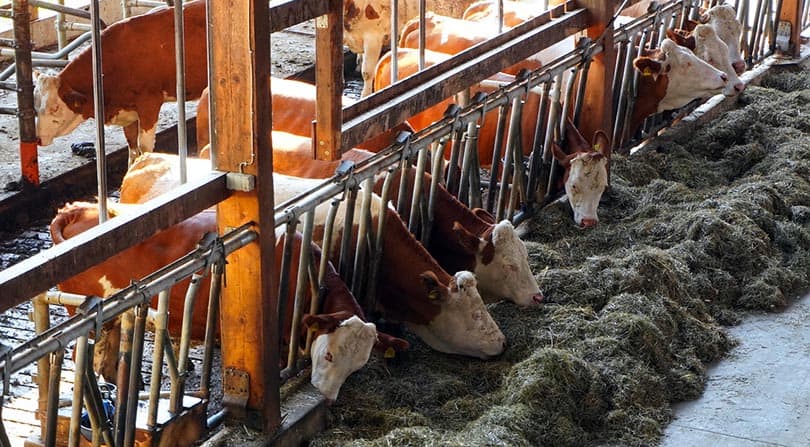Note: This article’s statistics come from third-party sources and do not represent the opinions of this website.
Factory farming, or intensive farming, is considered economical. Proponents claim that it is the only way to meet people’s increasing demands for various types of meat. However, the practice has many opponents that point to horrendous cruelty and the fact that cases of animal abuse are rife throughout the industry. Below are 14 facts about this practice.
Click to Skip Ahead:
- General Factory Farming Statistics
- Saddest Chicken Factory Farming
- Most Heart-wrenching Pig Factory Farming
- Most Cruel Cow Factory Farming Statistics

The 14 Factory Farming Statistics
- 99% of the US’s food livestock is factory farmed
- Factory farm animals are fattened at three times their natural rate
- 80% of antibiotics produced globally are for farm animals
- There are more than 25,000 factory farms in the US alone
- Induced molting causes 1 in 10 factory chickens to die
- 9% of US chickens, and 99.8% of turkeys, come from factory farms
- 2,000 chickens are slaughtered every second
- Young piglets have their tails removed and teeth clipped. Without anesthetic
- Sows are impregnated within two weeks of giving birth
- Piglets are slaughtered at 6 months of age and few see daylight
- 80% of slaughtered pigs suffer from pneumonia
- 70% of US cows are factory farmed
- Babies are removed from mother cows within a day of being born
- An average dairy cow only lives five years
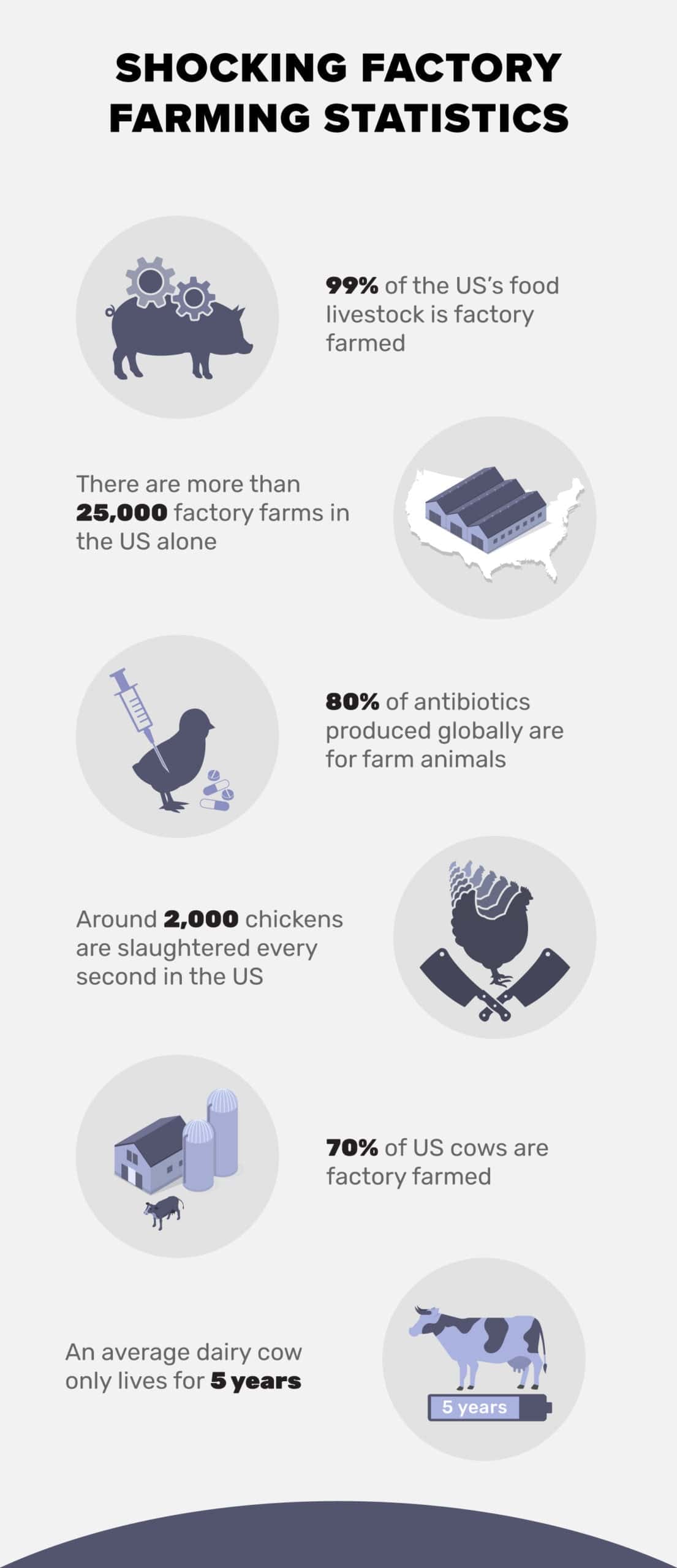

The 4 General Factory Farming Statistics
1. 99% of the US’s food livestock is factory farmed
(Sentience Institute)
Nearly three-quarters of US citizens claim that they eat humanely kept and killed livestock, yet figures show that 99.9% of chickens and 99.8% of turkeys eaten in the US came from factory farms. Producers do not highlight inhumane conditions, and consumers are typically unaware of the conditions that the animals are kept in.
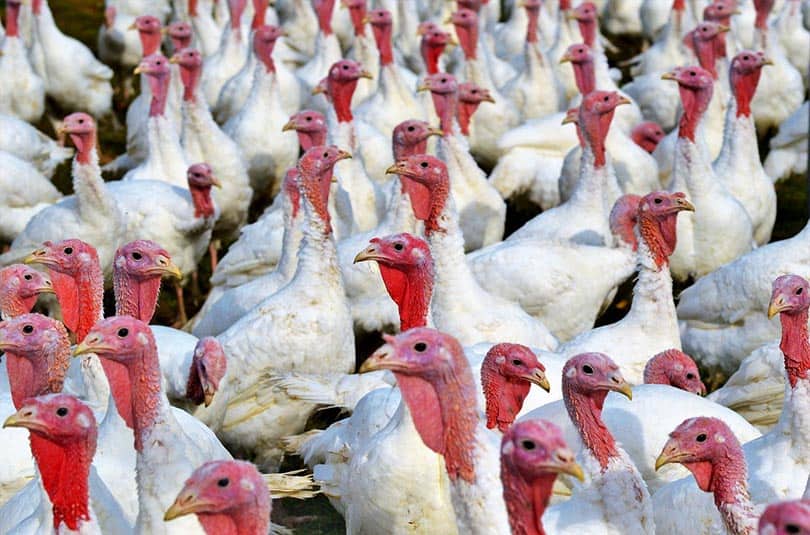
2. Factory farm animals are fattened at three times their natural rate
(United Poultry Concerns)
Chickens are 20% heavier than they were 50 years ago and reach this weight within 35 days, as a pose to the 90 days it took five decades ago, and this is up to four times quicker than the natural growth rate of the animal.
3. 80% of antibiotics produced globally are for farm animals
(FoodPrint)
Although there is some evidence that their widespread use is being outlawed in some countries, factory farmers are known to feed antibiotics to all of their livestock to prevent illness and infection. Because consumers ingest the antibiotics within the meat, it means that antibiotics are being less effective in people.

4. There are more than 25,000 factory farms in the US alone
(Food & Water Watch)
1.6 billion animals are kept in more than 25,000 factory farms in the US alone. That’s a 15% increase in the number of factory-farmed animals since 2012.

The 3 Saddest Chicken Factory Farming
5. Induced molting causes 1 in 10 factory chickens to die
(United Poultry Concerns)
Induced molting is a process that requires the starving of chickens for a period of between five and 14 days. Many chickens die during the process, while others choke to death when food is reintroduced after the molting process.
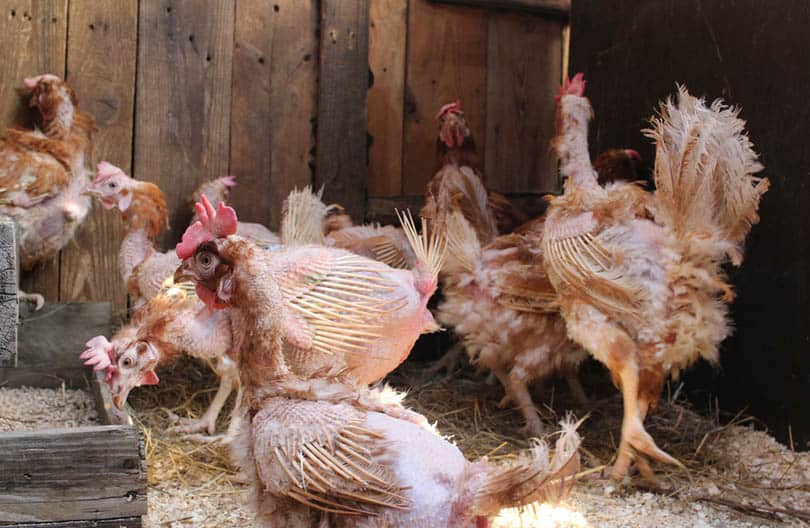
6. 9% of US chickens, and 99.8% of turkeys, come from factory farms
(USDA Census of Agriculture)
The most recent Census of Agriculture from the USDA shows that 99.9% of chickens and 99.8% of turkeys used for meat are raised on factory farms, where conditions are known to be very poor.
7. 2,000 chickens are slaughtered every second
(World Animal Protection)
The average US consumer eats more than 80 pounds of chicken a year, which results in more than 2,000 chickens being slaughtered every single second.
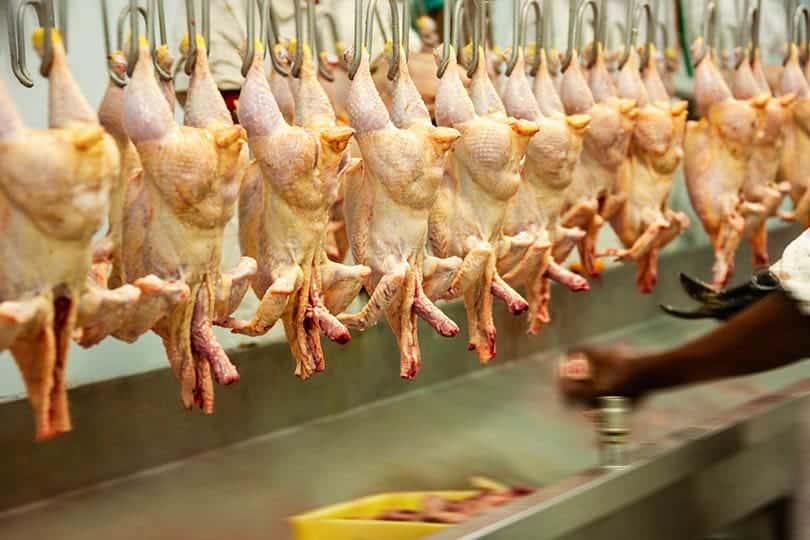

The 4 Most Heartwrenching Pig Factory Farming
8. Young piglets have their tails removed and teeth clipped. Without anesthetic
(European Parliament)
Piglets as young as two weeks old have their tails removed, teeth clipped, and are castrated, all with no anesthetic. Experts believe that piglets of all ages experience considerable pain during the procedures and may suffer chronic lifelong pain as a result.
9. Sows are impregnated within two weeks of giving birth
(ASPCA)
Not only are pregnant sows kept in a crate so small that they cannot turn around, but they will be impregnated within two weeks of giving birth to piglets.

10. Piglets are slaughtered at 6 months of age, and few see daylight
(PETA)
Sows live in brutal conditions for most of their lives. They are kept in “gestation” crates that are too small to turn around in, when pregnant. They are moved to “farrowing” crates, that are just big enough to lay down in, to give birth, and are impregnated within two weeks of giving birth. This cycle continues until she is no longer considered useful and is slaughtered, usually at three years of age.
11. 80% of slaughtered pigs suffer from pneumonia
(MSD Manual)
Between 30% and 80% of pigs slaughtered around the world show signs of having pneumonia because of the poor conditions in factory farms.
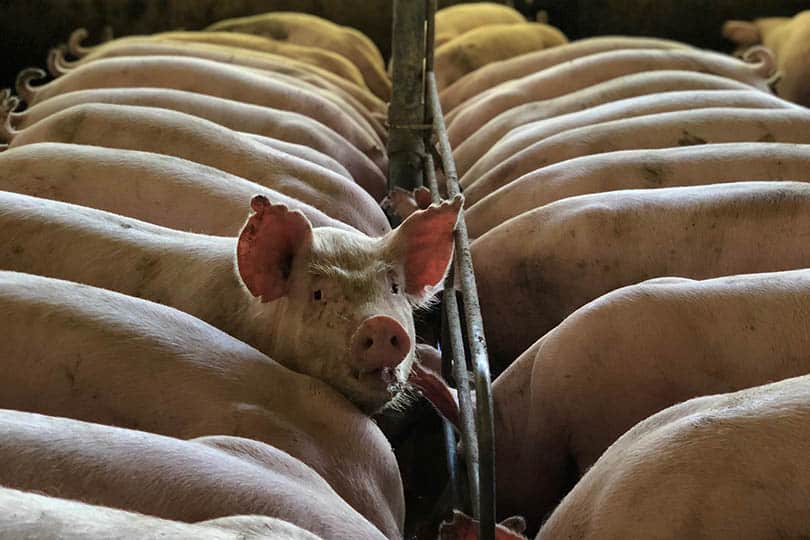

The 3 Most Cruel Cow Factory Farming Statistics
12. 70% of US cows are factory farmed
(USDA Census of Agriculture)
America has the second-highest meat consumption levels of any country in the world, consuming nearly 300 pounds each. This is an increase of 40% in the past 60 years. The average US citizen is estimated to eat more than 80 pounds of beef and buffalo every 12 months and 70% of this beef comes from livestock in factory farms.
13. Babies are removed from mother cows within a day of being born
(National Humane Education Society)
Cows give birth approximately every year for three or four years in factory farms. Male calves are removed within 24 hours of being born and put in veal crates, where they will never see daylight.
14. An average dairy cow only lives five years
(National Humane Education Society)
Dairy cows are forced to give birth every year to ensure a steady supply of milk. Once they are unable to give birth or cannot produce what is deemed an adequate supply of milk, they are slaughtered. In the wild, a cow lives approximately 25 years, but a dairy cow will usually be slaughtered after just five.
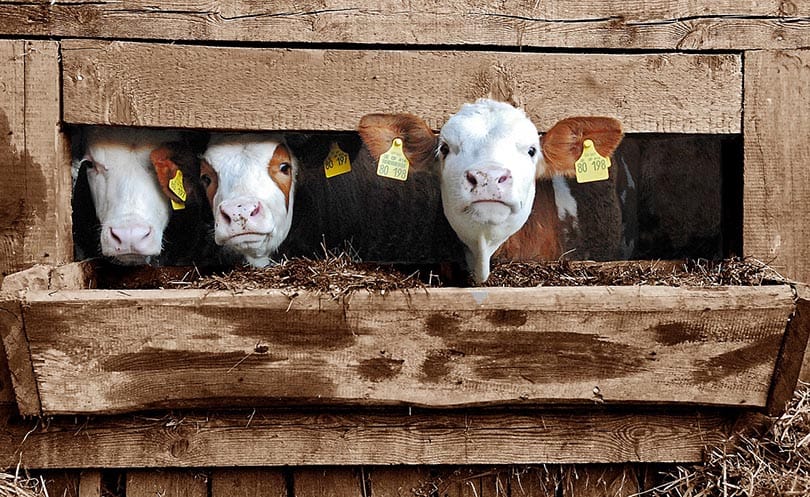

Frequently Asked Questions About Factory Farming
How Much Space Do Factory Farmed Chickens Have?
A typical factory farm chicken spends its entire life in a cage that is smaller than a piece of A4 paper, or the size of an iPad. This means that they barely have enough room to move and are often unable to peck the floor below them, let alone bathe in dust. (World Animal Protection)
Is Factory Farming Bad For The Environment?
One acre of rainforest is chopped down every six seconds to make way for farming and it takes the equivalent to 50 bathtubs full of water to produce just a single pound of meat. That’s several thousand bathtubs per year for an average US citizen. What’s more, more than one-third of methane emissions are produced by factory farming. (PETA)

Is Factory Farmed Meat Bad For Humans?
Cows and other livestock are routinely given “byproduct feedstuff” which is impossible to identify by name. When humans eat the resulting meat, they will be taking on some of these ingredients, which are known to include byproducts from the manufacture of candy, alcoholic drinks, to less innocuous ingredients like potatoes. Factory farmed food is also known to be lower in vitamin E, beta carotene, and omega-3, all of which are essential nutrients in our diet. (National Library Of Medicine)
How Many Animals Are Killed Every Year?
Approximately 2.7 billion larger animals, including pigs, sheep, goats, and cattle are slaughtered every year to feed humans. But this figure is dwarfed by the 50 billion chickens that are slaughtered for our tables in 12 months. (UN Food and Agriculture Organization)
What Percentage of Farming Is Factory Farming?
Approximately two-thirds, or 67%, of all animals farmed are found on factory farms, which is equivalent to nearly 50 billion animals and includes almost every type of meat animal from chickens to goats to cows. (Compassion In World Farming)


Conclusion
A brighter spotlight is being shone on the world’s farming and factory farming practices but despite laws being introduced to curb practices such as unanaesthetized detailing and to prevent the use of small cages, these practices do continue. What’s more, the figures show that factory farming could be harming human health, potentially even with regards to antibiotic immunity, and it certainly impacts the environment.
Related Reads:
- Disheartening Circus Animal Statistics
- Disheartening Animals in Captivity Statistics
- Animals That Are Becoming Domesticated as Pets (With Pictures)
Featured Image Credit: matthiasboeckel, Pixabay
